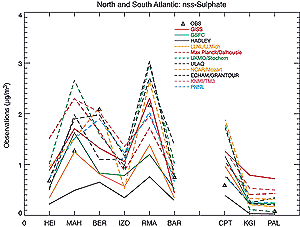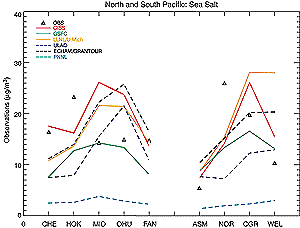5.4.1.3 Comparison of modelled and observed aerosol concentrations
Like previous model intercomparisons, the IPCC comparison showed large differences
(factor of 2) in model predictions of the vertical distribution of aerosols.
The model simulations of surface sulphate concentrations (Figure
5.8) indicate that much of the difference in sulphate radiative forcing
reported in the literature is most likely to be associated with either variations
in the vertical distribution or with the response of sulphate aerosols to variations
in relative humidity (Penner et al., 1998b).
The IPCC comparison showed that the capability of models to simulate other
aerosol components is inferior to their capability to simulate sulphate aerosol.
For example, sea salt in the North and South Pacific shows poorer agreement,
with an average absoute error of 8 mgm-3 (Figure 5.9) than
the corresponding sulphate comparison which is less than 1 mgm-3 (Figure
5.8) (see Table 5.9 also).
|

Figure 5.8: Observed and model-predicted annual average concentrations
of non-sea salt sulphate (in µgm -3 ) at a series of
stations in the North and South Atlantic. The models are listed in Table
5.8. Data were provided by D. Savoie and J. Prospero (University of
Miami). Stations refer to: Heimaey, Iceland (HEI); Mace Head, Ireland
(MAH); Bermuda (BER); Izania (IZO); Miami, Florida (RMA); Ragged Point,
Barbados (BAR); Cape Point, South Africa (CPT); King George Island (KGI);
and Palmer Station, Antarctica (PAL).
|

Figure 5.9: Observed and model-predicted annual average concentrations
of sea salt (as Na) (in µgm-3) at a series of stations in the North
and South Pacific. The models are listed in Table
5.8. Data were provided by D. Savoie and J. Prospero (University of
Miami). Stations refer to: Cheju, Korea (CHE); Hedo, Okinawa, Japan (HOK);
Midway Island (MID); Oahu, Hawaii (OHU); Fanning Island (FAN); American
Samoa(ASM); Norfolk Island (NOR); Cape Grim, Tasmania (CGR); and Wellington/Baring
Head, New Zealand (WEL).
|
For dust the model-observation comparison showed a better agreement with surface
observations in the Northern than in the Southern Hemisphere. For example, the
average absolute error in the Northern Pacific was 179%, while it was 268% in
the Southern Pacific. In the Southern Hemisphere, almost all models predict
concentrations higher than the observations at all stations poleward of 22°S.
Thus, it appears that dust mobilisation estimates may be too high, particularly
those for Australia and South America. The paucity of dust from these regions
relative to other arid dust source areas has been noted previously (Prospero
et al., 1989; Tegen and Fung, 1994; Rea, 1994), and may reflect the relative
tectonic stability, low weathering rates, duration of land-surface exposure,
and low human impacts in this area.
| Table 5.9a: Comparison of models and observations
of aerosol species at selected surface locations ( µg/m3)a,b. |
 |
|
Model
|
Sulphate
|
Black carbon
|
Organic carbon
|
Dust
|
Sea salt
|
Average
bias
(µg/m3)
|
Average
absolute
error
(µg/m3)
|
Average
bias
(µg/m3)
|
Average
absolute
error
(µg/m3)
|
Average
bias
(µg/m3)
|
Average
absolute
error
(µg/m3)
|
Average
bias
(µg/m3)
|
Average
absolute
error
(µg/m3)
|
Average
bias
(µg/m3)
|
Average
absolute
error
(µg/m3)
|
 |
| GISS |
0.15
|
0.33
|
0.16
|
0.61
|
0.69
|
1.52
|
5.37
|
5.37
|
3.90
|
11.94
|
| GSFC |
-0.10
|
0.28
|
0.71
|
1.00
|
0.71
|
1.57
|
-0.5
|
1.98
|
-3.02
|
9.23
|
| Hadley |
-0.54
|
0.55
|
0.74
|
1.18
|
|
|
-2.47
|
3.48
|
|
|
| CCM/Grantour |
-0.31
|
0.40
|
-0.18
|
0.50
|
-0.84
|
1.20
|
1.77
|
2.99
|
5.26
|
14.48
|
| ECHAM |
0.09
|
0.42
|
0.74
|
1.07
|
1.52
|
2.09
|
|
|
|
|
| Stochem |
0.34
|
0.40
|
|
|
|
|
|
|
|
|
| ULAQ |
0.18
|
0.34
|
-0.30
|
0.48
|
-0.47
|
1.43
|
1.82
|
3.69
|
0.81
|
12.57
|
| Mozart |
0.05
|
0.39
|
-0.34
|
0.51
|
|
|
|
|
|
|
| ECHAM/Grantour |
0.26
|
0.28
|
0.07
|
0.55
|
-0.57
|
1.40
|
5.2
|
5.27
|
2.07
|
10.55
|
| TM3 |
0.27
|
0.47
|
|
|
|
|
|
|
|
|
| PNNL |
-0.04
|
0.28
|
0.16
|
0.64
|
0.79
|
1.50
|
-2.48
|
2.64
|
-13.46
|
13.74
|
| Average of all models |
0.03
|
0.38
|
0.20
|
0.73
|
0.26
|
1.53
|
2.73
|
3.86
|
-0.74
|
12.09
|
 |
| Table 5.9b: Comparison of models and observations
of aerosol species at selected surface locations (%)a,b. |
 |
|
Model
|
Sulphate
|
Black carbon
|
Organic carbon
|
Dust
|
Sea salt
|
Average
bias
(%)
|
Average
absolute
error
(%)
|
Average
bias
(%)
|
Average
absolute
error
(%)
|
Average
bias
(%)
|
Average
absolute
error
(%)
|
Average
bias
(%)
|
Average
absolute
error
(%)
|
Average
bias
(%)
|
Average
absolute
error
(%)
|
 |
| GISS |
26
|
31
|
85
|
127
|
91
|
121
|
121
|
121
|
37
|
40
|
| GSFC |
7
|
15
|
189
|
219
|
109
|
134
|
39
|
42
|
21
|
30
|
| Hadley |
-11
|
16
|
140
|
220
|
|
|
|
|
|
|
| CCM/Grantour |
1
|
15
|
43
|
111
|
13
|
85
|
78
|
80
|
63
|
68
|
| ECHAM |
32
|
35
|
253
|
276
|
276
|
285
|
|
|
|
|
| Stochem |
30
|
34
|
|
|
|
|
|
|
|
|
| ULAQ |
10
|
17
|
-10
|
84
|
23
|
100
|
21
|
35
|
81
|
88
|
| Mozart |
28
|
31
|
164
|
211
|
|
|
|
|
|
|
| ECHAM/Grantour |
31
|
31
|
204
|
230
|
88
|
135
|
70
|
70
|
29
|
33
|
| TM3 |
43
|
46
|
|
|
|
|
|
|
|
|
| PNNL |
17
|
21
|
75
|
133
|
189
|
220
|
|
|
-12
|
16
|
| Average of all models |
19
|
26
|
127
|
179
|
112
|
154
|
66
|
70
|
36
|
46
|
 |
Continued on next page
|